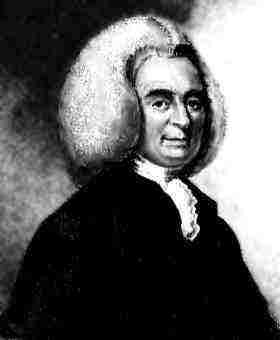|
 Colin
Maclaurin was a Scottish mathematician who was the first person
to present the correct theory for distinguishing between the maximum
and minimum values of a function and who played a vital role in
establishing the dominance of Newton calculus in eighteenth century
Great Britain. Although Maclaurin is regarded by many as one of
the ablest mathematicians of the 18th century, his
fame did not come easy. Six years after his birth in Kilmoden,
his father died and his mother died before he was ten, leaving
the remainder of his childhood and adolescent life to be raised
by his uncle, an incumbent in the parish of Kilfinnan. Instilled
with his many of his uncle's ideals, Maclaurin began his formal
education in 1709 at the University of Glasgow studying divinity,
however within the year , due largely to Robert Simpson's influence,
the Professor of Mathematics for mathematics, he abandoned his
study of divinity for his true calling, Mathematics. Colin
Maclaurin was a Scottish mathematician who was the first person
to present the correct theory for distinguishing between the maximum
and minimum values of a function and who played a vital role in
establishing the dominance of Newton calculus in eighteenth century
Great Britain. Although Maclaurin is regarded by many as one of
the ablest mathematicians of the 18th century, his
fame did not come easy. Six years after his birth in Kilmoden,
his father died and his mother died before he was ten, leaving
the remainder of his childhood and adolescent life to be raised
by his uncle, an incumbent in the parish of Kilfinnan. Instilled
with his many of his uncle's ideals, Maclaurin began his formal
education in 1709 at the University of Glasgow studying divinity,
however within the year , due largely to Robert Simpson's influence,
the Professor of Mathematics for mathematics, he abandoned his
study of divinity for his true calling, Mathematics.
Maclaurin
quickly became a mathematical prodigy. At age fifteen he took
his master's degree and gave a remarkable public defense of his
thesis on the power of gravity, entitled, "On the Power of
Gravity". At age 19 he was appointed the Professor of Mathematics
at Marischal College of Aberdeen. In 1719, at age 21, he published
his first important work called, Geometria organica. However,
at this time, his life and study once again took another turn.
Soon after befriending Issac Newton and being appointed to the
Royal Academy in 1721, Maclaurin left Aberdeen, without official
leave, to become the traveling tutor to the English Diplomat,
Lord Polwath's oldest son. As he tutored, he continued to gain
notoriety from his peers. For example, the French Academy of Science
awarded him for his paper on "The Percussian of Bodies",
(later included in substance in his treatise on fluxions). However,
his pupil died in 1724, Maclaurin felt a longing to return to
Scotland and his colleauges at Aberden. Since, he had forfeited
his goodwill when he left Aberden, he went to Edinburgh to teach.
At Edinburgh, Maclaurin had difficulty in obtaining a salary to
cover his assistantship. Fortunately, thanks to Issac Newton offer
to personally provide funds to secure Maclaurin's skills and Newton's
benevolence, Maclaurin was appointed the Deputy Professor of Mathematics
at Edinburgh. Soon After he succeeded to the position of chair.
The
for next twenty years Maclaurin focused much of his attention
on his exposition on Newton's method of fluxions. Written mainly
as a retort to Bishop Berkeley's attack on the principles of calculus
and in an effort to provide a geometrical framework and logical
justification for Newton's fluxion calculus , Maclaurin's, "The
Treatise of Fluxions", was a widely praised and very powerful
work in terms of its effect on the development mathematics at
the time. In effect, "The Treatise of Fluxions" played
a vital role in the dominance of Newtonian mathematics. This mathematics
effectively cut off Britain's mathematical developments in Europe
for the next three generations, leaving the continental mathematicians
free to establish the foundation for modern mathematical analysis.
Maclaurin also included many other important developments in ,
"The Treatise of Fluxions", his papers on the gravitational
influence on tides, vital solutions to geometric problems and
theories of attractions, and a method for defining the maximum
and minimum points on a curve. The papers on the gravitational
influence of tides, for instance, proved that an ellipsoid of
evolution is formed whenever a homogeneous fluid mass under the
action of gravity resolves uniformly about an axis.
In
addition to his work on "The Treatise of Fluxions",
Maclaurin spent the remainder of his years giving popular public
and Edinburgh society lectures on physics and astronomy. Maclaurin
also developed a specific theorem, which is a special case of
the Taylor theorem, that can be used to find the series for functions
such as loge, (1+x), ex, sin x, cos x, tan
x, etc., where e is the base of natural logarithms. Unfortunately,
Maclaurin died in 1745, a year and a half after he fell ill from
oedema after organizing the defense of Edinburgh and just four
years after the publication of his famed "The Treatise of
Fluxions". Colin Maclaurin remains today as the first person
to successfully present a logical and systematic exposition of
Newton's fluxions and calculus.
Home >
Biographies
|